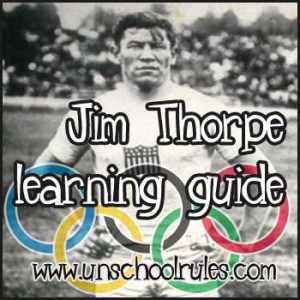 When our family visited the National Museum of the American Indian in Washington, D.C., back in 2012, one of the key exhibits we saw focused on Native American participation in the Olympics. And, of course, one of the focal points was decathlon- and pentathlon-winner Olympian Jim Thorpe.
When our family visited the National Museum of the American Indian in Washington, D.C., back in 2012, one of the key exhibits we saw focused on Native American participation in the Olympics. And, of course, one of the focal points was decathlon- and pentathlon-winner Olympian Jim Thorpe.
In fact, Ashar’s souvenir from that stop on our trip was the Sterling Biographies copy of Thorpe’s life story! We started reading it right away, and finished it a little more than a month later.
And when Ashar planned out the places she wanted us to visit and the things she wanted to learn about for her seventh-grade year, Jim Thorpe made it onto both lists, in the form of the man AND his now-namesake town.
So one Friday in November 2012, on a rare weekday off, we decided to take a family field trip to Jim Thorpe, Pennsylvania, just about three and a half hours away from our home.
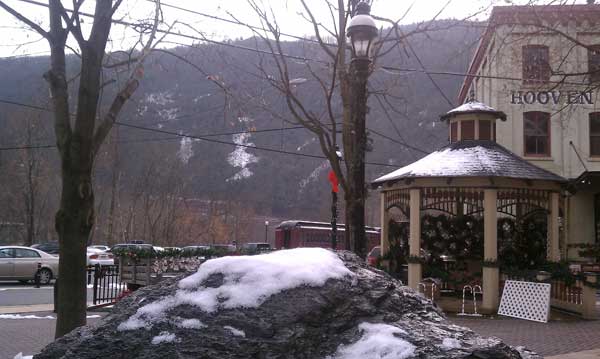
The town of Jim Thorpe (formerly Mauch Chunk)
His remains – and a fairly not-prominent monument – are in the town that was formerly known as Mauch Chunk, in the middle of the coal mountains of Pennsylvania, because it seemed like a good idea back in the 1950s. Jim Thorpe had passed away in 1953, and his widow (his third wife, Patricia) was upset because his home state, Oklahoma, had no desire to put up any kind of monument.
Enter Mauch Chunk, which was merging with a nearby town and wanted to draw some attention to itself.
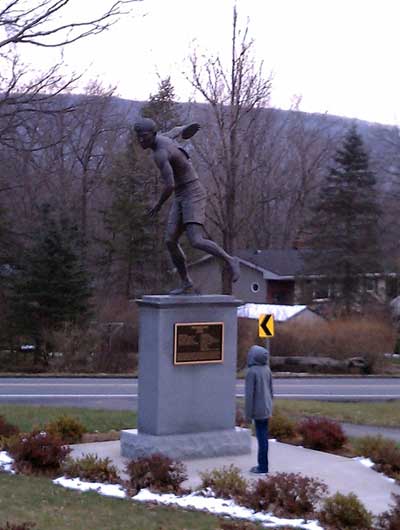 The town, which had grown a result of the anthracite coal boom (that’s a huge hunk of anthracite in the foreground of the photo above, by the way), was actually best known as the home of the gravity railroad. This attraction was kind of the roller coaster of its day, and continued running as a tourist attraction even after the need to roll coal down a mountain waned. Once cars became more common, though, people didn’t think it was so fun to take a trolley to Jim Thorpe and ride the gravity railroad, and the town needed a boost.
The town, which had grown a result of the anthracite coal boom (that’s a huge hunk of anthracite in the foreground of the photo above, by the way), was actually best known as the home of the gravity railroad. This attraction was kind of the roller coaster of its day, and continued running as a tourist attraction even after the need to roll coal down a mountain waned. Once cars became more common, though, people didn’t think it was so fun to take a trolley to Jim Thorpe and ride the gravity railroad, and the town needed a boost.
If you visit Jim Thorpe, it’s worth the $5 admission to visit the Mauch Chunk Museum and Cultural Center. You’ll get to see a 20-minute film about the town’s history, see a model of the gravity railroad system and even check out a small display about Thorpe the athlete.
The downtown is an interesting place to walk around as well – lots of small stores to visit, including a bookstore where we found Ashar’s current favorite book, which I’ll talk about in my next Reading Roundup post! Oh, and a wonderful tea shop/absinthe house (now there’s something you don’t get to say every day).
Other things to do in or around Jim Thorpe
- Tour the mansion of industrialist Harry Packer, which supposedly might have been the inspiration for Walt Disney World’s “Haunted Mansion.”
- Ride the Lehigh Gorge Scenic Railway, where a narrated tour shows you why the scenic town was once called “The Switzerland of America.”
See the Bear Mountain Butterfly Sanctuary. This would have been AMAZING, especially after our butterfly experience in Washington, D.C, but it was closed for the season by the time we went!
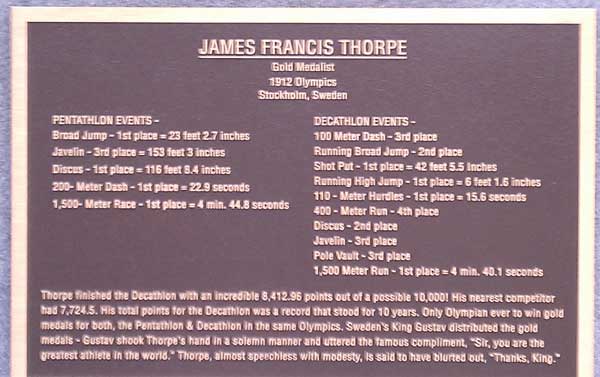
Jim Thorpe the athlete
Jim Thorpe, who was born May 22, 1887, has been called the greatest athlete in the world – first by Sweden’s King Gustav after he won gold in both the decathlon and pentathlon in the 1912 Stockholm Olympics, but later by magazines, newspapers, sporting organizations and more.
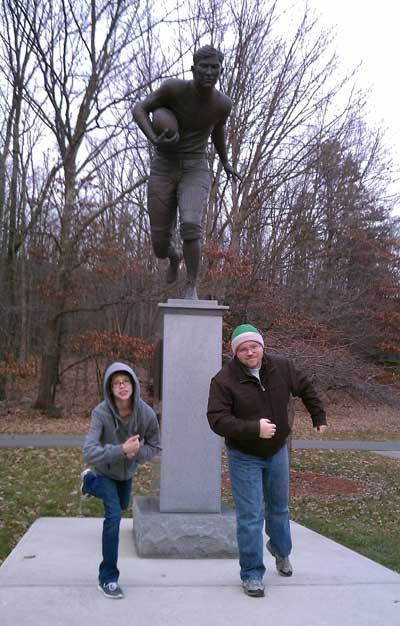 In addition to his skill in track – and you can see his amazing accomplishments there on the plaque above, which is seen at his memorial – he was exceptional in other sports, too.
In addition to his skill in track – and you can see his amazing accomplishments there on the plaque above, which is seen at his memorial – he was exceptional in other sports, too.
He’s in the Pro Football Hall of Fame in Canton, Ohio, and, in fact, was the first president of what would later become the NFL. He played six seasons of Major League Baseball – the cause of his Olympic victory dethroning.
The coolest Jim Thorpe sports fact I learned? Thorpe hit three home runs into three different states during one game. It was on the border of Texas, Arkansas and Oklahoma, and when he hit his home runs, one went over the left field wall into Oklahoma; another went into center field, which was in Texas; and the other went over the right field wall into Arkansas. OK, that’s pretty neat. (There are some more good Jim Thorpe facts here.)
You can read more about Thorpe’s career on his Wikipedia page, which has probably the best online bio I’ve found for him. (I really do recommend reading a good biography, which will go more in-depth!)
His former home in Yale, Oklahoma has now been preserved and is operated as a museum; while that’s a bit out of my travel radius, it’s certainly worth a visit if you’re in that area.
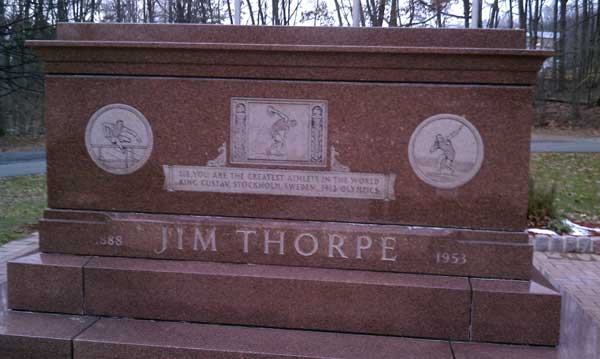
The Jim Thorpe controversies
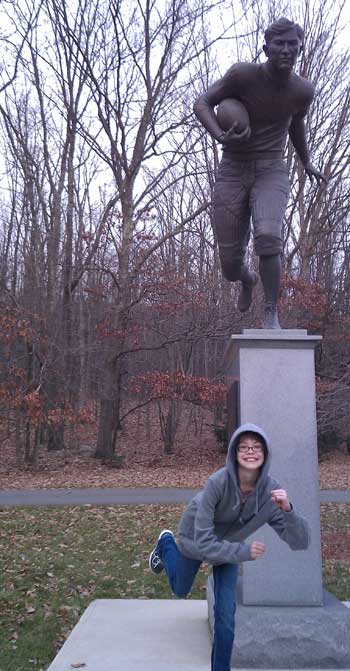 Many who are familiar with Jim Thorpe are, sadly, aware of him for his notoriety – he had his Olympic medals stripped from him because he was found to have played professional sports (then a violation of Olympic Committee rules) because he’d been a semi-pro baseball barnstormer for a few months.
Many who are familiar with Jim Thorpe are, sadly, aware of him for his notoriety – he had his Olympic medals stripped from him because he was found to have played professional sports (then a violation of Olympic Committee rules) because he’d been a semi-pro baseball barnstormer for a few months.
It wasn’t until 1983, 30 years after his death, that his family received new medals, reissued; no one even knows what happened to the originals, though they’re thought to have been stolen.
But there’s another controversy involving the town that now bears Thorpe’s name – it has since debated changing its name back to Mauch Chunk, because the renaming didn’t bring the promised fame or money.
Though it looks like it’ll stay Jim Thorpe, you get the feeling from visiting the town that there’s a mixed level of interest in the athlete; his memorial, for instance, is outside of the main tourist part of town, and not marked well on most of the visitors’ guide literature. Yet the museum had a good display of Thorpe items, and even the local high school continues its support – their teams are the Jim Thorpe Olympians, which was neat to see.
We did enjoy seeing the memorial – and Ashar liked posing like “Football Jim,” showing off yet another of the sports he excelled at.
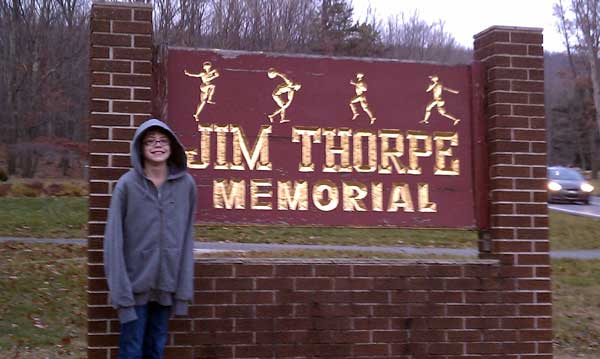
Read more
This post is part of an occasional series of “Family Field Trip” posts, combining our own adventures with resources we’ve found helpful. Many of these will work even if you can’t visit in person!
 Earlier in the series, we shared free resources to help you learn about Philadelphia, Independence Hall and the Liberty Bell and others to help you learn about and make the most of a visit to Assateague, Md., and Chincoteague, Va.
Earlier in the series, we shared free resources to help you learn about Philadelphia, Independence Hall and the Liberty Bell and others to help you learn about and make the most of a visit to Assateague, Md., and Chincoteague, Va.
I’ve also been doing a loose series of posts good for unit studies. An earlier post in that series shared our favorite Phantom of the Opera learning resources and we also shared our favorite solar-system learning materials!
This post is also part of the iHomeschool Network’s Best Homeschool Field Trips linkup. Click the image to read more!
And, if you’re interested, there are many more cool “May birthday” lessons from my fellow iHomeschool Network bloggers. Click the image below to check them out!

You can check out more posts in our Learning Party series here!
More great history resources
 This post is part of the iHomeschool Network Massive Guide to Homeschooling History.
This post is part of the iHomeschool Network Massive Guide to Homeschooling History.
Make sure to check it out for tons of other great history resources, including links to a dozen more Unschool Rules posts!


I loved this post. I learned a lot that I didn’t know. I love it when kids go down a path of learning and really uncover a lot of fun. You are a real inspiration to me. I love field trips and we take a fair number of them, but I was never satisfied with how to post them to make them interesting. Well, this is a wonderful example of how to do just that. Thank you.
Wow, thanks, Phyllis! I want to come over and link it up to your history/geography post – I hope it’ll be a helpful overview! And thank you SO MUCH for the kind words on the post! I think you do a great job – I love seeing all the places you go. And I have to tell you I admire you all the more for doing it with a large family; sometimes it’s a job just getting THREE of us somewhere!
Looks like a beautiful little town!
It made for an awesome day trip – great drive to it, great to walk around, pretty coming home. Would have been even better in the fall as the leaves changed, I bet!
“Fairly not-prominent”? I disagree with that characterization of his final resting place and your own photos dispute this. I would also add once you place it in the context of the time period, economic state of the community, etc., your description of even the original mausoleum is further undermined and this is before we examine the site today with its narrative boards, lighting, and added statues that will soon include another paying homage to his excellence in baseball.
Carbon County Commissioner Chris Lukasevich and proud native son of Jim Thorpe, PA.